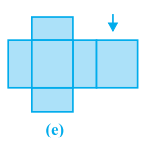SURFACE AREAS AND VOLUMES
Introduction
So far, in all our studies, we have been dealing
with figures that can be easily drawn on our notebooks or blackboards. These are
called plane figures. We have understood what rectangles, squares, and circles are,
what we mean by their perimeters and areas, and how we can find them.
It would be interesting to see what happens if we cut
out many of these plane figures of the same shape and size from a cardboard sheet and
stack them up in a vertical pile. Through this process, we shall obtain some solid figures
(briefly called solids) such as a cuboid, a cylinder, etc. You will learn to find the surface areas and volumes of cuboids, cubes, cylinders, cones, and spheres.
Surface Area of a Cuboid and a Cube
Have you looked at a bundle of many sheets of paper? How does it look? Does it look
like what you see in Fig?
That makes up a cuboid. How much of brown paper would you need, if you want
to cover this cuboid?
👉 First we would need a rectangular piece to cover
the bottom of the bundle. That would be as shown in
Fig. (a).
👉 Then we would need two long rectangular pieces
to cover the two side ends. Now, it would look like
Fig. (b).
👉 Now to cover the front and back ends, we would
need two more rectangular pieces of a different sizes.
With them, we would now have a figure as shown in
Fig.(c).
👉 This figure, when opened out, would look like
Fig. (d).
👉 Finally, to cover the top of the bundle, we would
require another rectangular piece exactly like the one
at the bottom, which if we attach on the right side, it
would look like Fig. (e).
This shows us that the outer surface of a cuboid is made up of six rectangles (in
fact, rectangular regions, called the faces of the cuboid), whose areas can be found by
multiplying length by breadth for each of them separately and then adding the six
areas together.
Now, if we take the length of the cuboid as `l`, breadth as `b` and the height as `h`, then
the figure with these dimensions would be like the shape you see in Fig. (f).
So, the sum of the areas of the six rectangles is:
Area of rectangle `1 (= l × h) +` Area of rectangle `2 (= l × b) +` Area of rectangle `3 (= l × h) +` Area of rectangle `4 (= l × b) +` Area of rectangle `5 (= b × h) +` Area of rectangle `6 (= b × h)`
`= 2(l × b) + 2(b × h) + 2(l × h)`
`= 2(lb + bh + hl)`
`\therefore `Surface Area of a Cuboid `= 2(lb + bh + hl)`
A cuboid, whose length, breadth and height are all equal, is called a
cube. If each edge of the cube is `a`, then the surface area of this cube would be
`2(a × a + a × a + a × a), i.e., 6a^ 2`
where `a` is the edge of the cube.
`\therefore` Surface Area of a Cube `= 6a ^2`
Suppose, out of the six faces of a cuboid, we only find the area of the four faces,
leaving the bottom and top faces. In such a case, the area of these four faces is called
the lateral surface area of the cuboid. So, lateral surface area of a cuboid of
length `l`, breadth `b` and height `h` is equal to `2lh + 2bh` or `2(l + b)h.` Similarly,
lateral surface area of a cube of side a is equal to ` 4a^2` .







